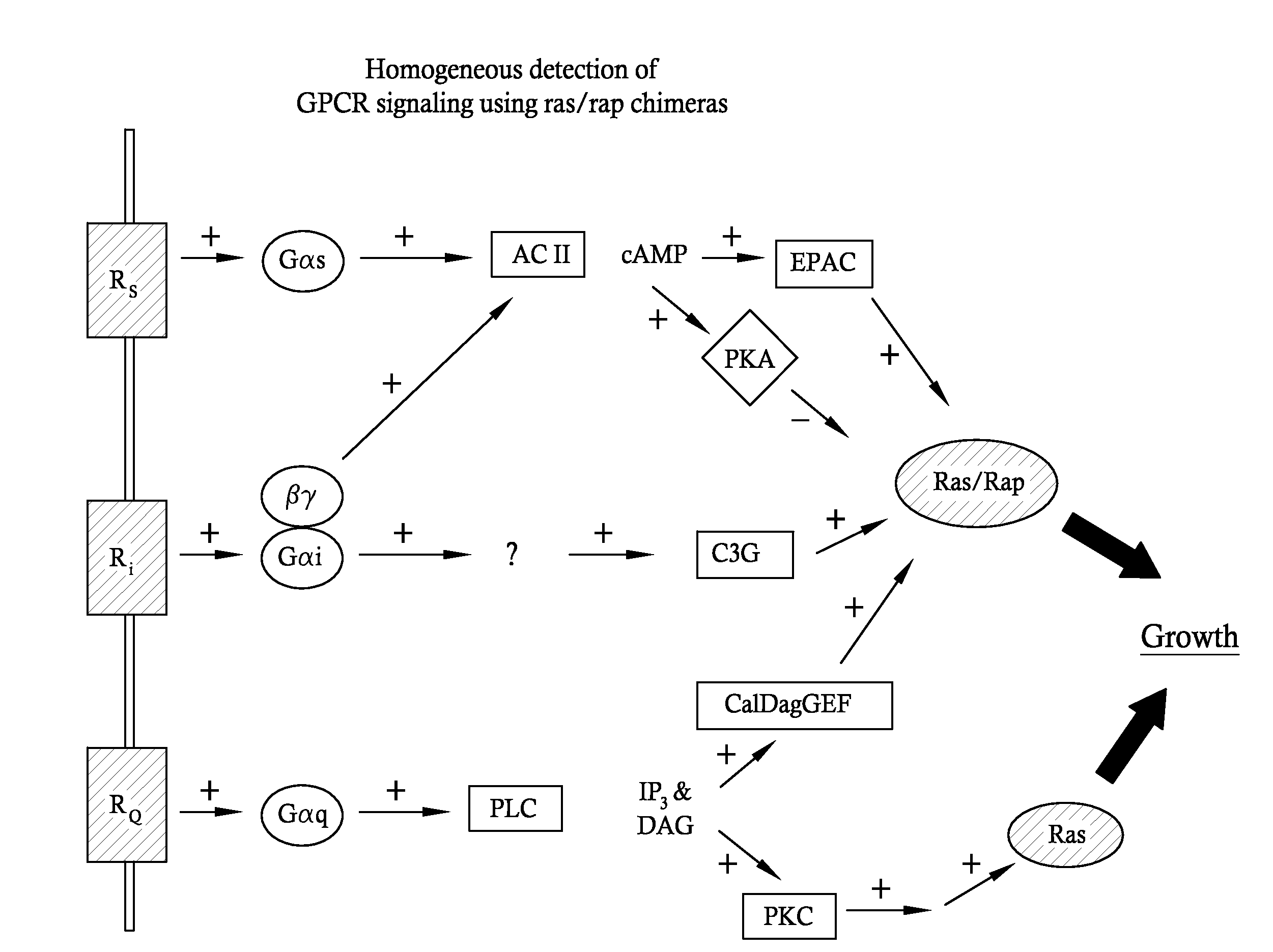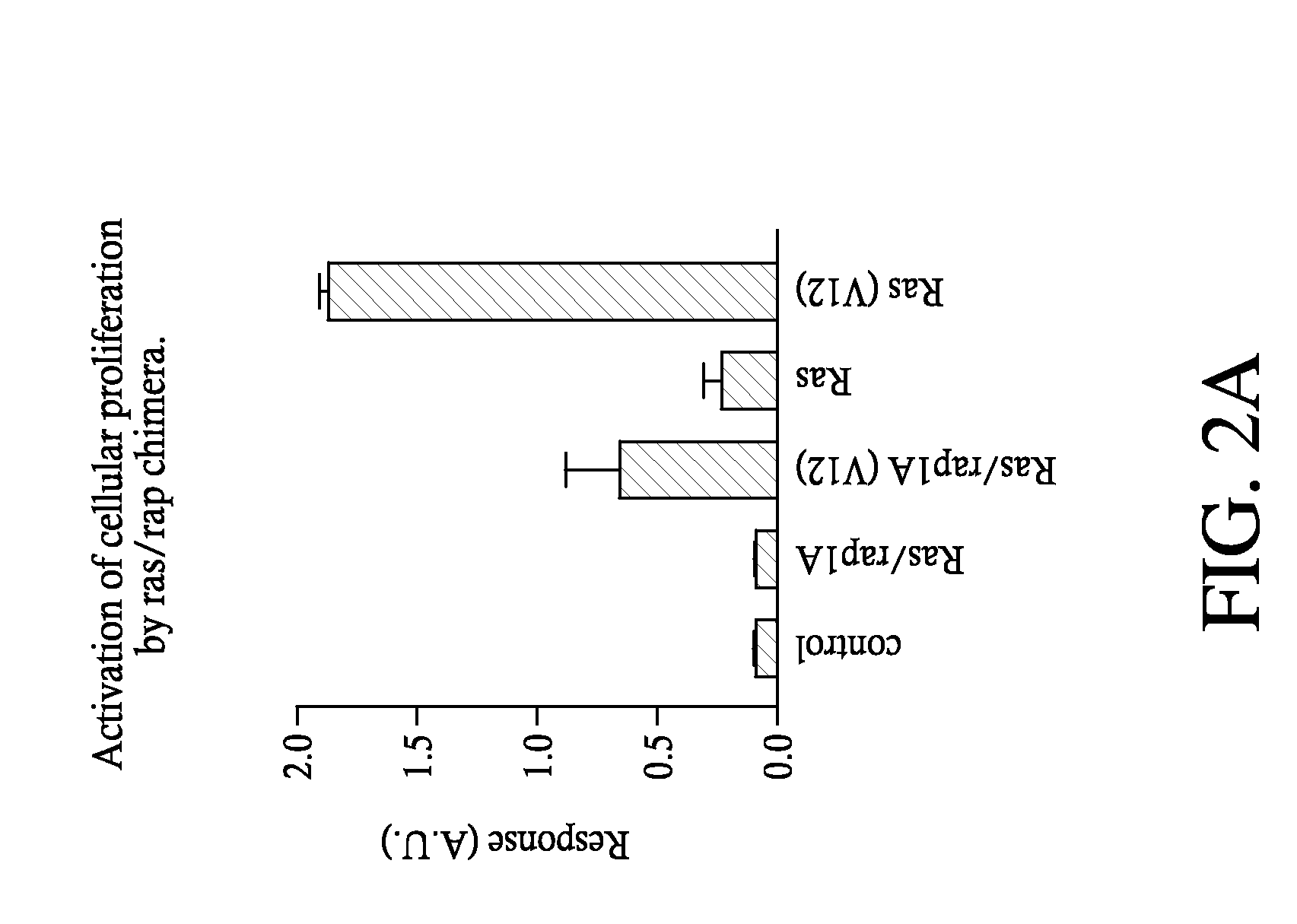G-protein coupled receptors high-throughput functional assay
a functional assay and g-protein technology, applied in the field of g-protein coupled receptor high-throughput functional assay, can solve the problems of inability to screen orphan receptors, difficult to develop functional assays with broad applicability, and inability to detect orphan receptors, etc., to achieve the effect of improving the detection of functional responses to receptors and enhancing the primary function respons
- Summary
- Abstract
- Description
- Claims
- Application Information
AI Technical Summary
Benefits of technology
Problems solved by technology
Method used
Image
Examples
example 1
[0042]This example describes and validates the construction and operation of a reporter chimera and a mutant reporter chimera each comprised of ras sequence fused to rap sequence.
[0043]The rap GTPases integrate signaling inputs from Gq, Gs and Gi linked GPCRs (23-29) and ras GTPases stimulate cellular growth in most cell types, thus in principle, ras / rap chimeras which respond to rap inputs, but which mediate ras outputs would link Gq, Gs and Gi derived signals to cellular proliferation. A diagram of this scheme is shown in FIG. 1. Previously it was shown that certain chimeras between ras and rap retained the ability to transform NIH3T3 cells (33), but in that study only GTPase deficient (deregulated) mutants were used, thus only the effector functions, but none of the regulatory functions of these chimeras were defined. In agreement with those earlier findings, we found that expression of the GTPase impaired mutant forms (derived from viral-ras, denoted v-) of ras, or a chimera bet...
example 2
[0045]This example demonstrates the utility of redirecting signaling pathways from non-proliferative to proliferative signals using helper genes.
[0046]Given that many GPCRs can activate rap we tested whether or not non-transforming GPCRs could stimulate cellular proliferation through the ras / rap chimeras. As shown in FIGS. 3A and 3B, the Gs-coupled D1 dopaminergic receptor, which stimulates production of cyclic AMP, and the Gi-coupled 5HT1E serotonergic receptor which selectively couples pertussis toxin sensitive G-proteins were unable to produce responses in R-SAT alone. However when these same receptors were co-transfected with ras / rap1B or ras / rapAA, robust agonist dependent responses were observed in R-SAT. Consistently we observed that responses were higher to the ras / rapAA construct indicating that phosphorylation by PKA was unnecessary. Ligand-binding studies showed that expression of ras / rap did not significantly affect expression of either D1 (2.6 pmol / mg alone vs. 2.4 pmol...
example 3
[0047]This example demonstrates some enabled receptors utilize Gi.
[0048]To evaluate the role of Gi-family G-proteins in mediating responses to D1 and 5HT1E, cellular proliferation was examined in the presence of pertussis toxin. As shown in FIG. 4A, pertussis toxin completely blocked ras / rap dependent responses to 5HT1E confirming that these responses were transduced through Gi-family G-proteins. In contrast, pertussis toxin did not block, and slightly increased ras / rap dependent responses to D1 confirming that D1 mediates stimulatory responses through pertussis insensitive G-proteins. Similar results were obtained with other Gi-linked receptors (FIG. 4B).
PUM
| Property | Measurement | Unit |
|---|---|---|
| concentrations | aaaaa | aaaaa |
| concentrations | aaaaa | aaaaa |
| volume | aaaaa | aaaaa |
Abstract
Description
Claims
Application Information
 Login to View More
Login to View More - R&D
- Intellectual Property
- Life Sciences
- Materials
- Tech Scout
- Unparalleled Data Quality
- Higher Quality Content
- 60% Fewer Hallucinations
Browse by: Latest US Patents, China's latest patents, Technical Efficacy Thesaurus, Application Domain, Technology Topic, Popular Technical Reports.
© 2025 PatSnap. All rights reserved.Legal|Privacy policy|Modern Slavery Act Transparency Statement|Sitemap|About US| Contact US: help@patsnap.com



